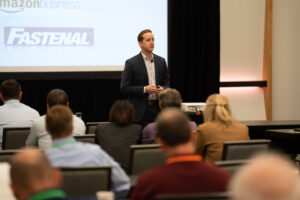Through the use of collaborative innovations like ShelfAware’s CloudSourcingTM, small businesses are quickly becoming the new “Big Business” in industrial manufacturing. CloudSourcing empowers collaboration among multiple independent and specialized product vertical suppliers. It empowers all suppliers to work together with a single consumer on ShelfAware’s unified supply chain platform. Learn about how ShelfAware changed the landscape for small business disruption.
To all of the small businesses out there, take heart. There is hope—a chance to compete with the big boys. Welcome to the era of disruptive technology, in particular RFID technology and the Internet of Things, that can change the landscape of any small business. It gives us the chance to compete on a level we never thought possible.
ShelfAware’s story of innovation demonstrates several keys points of underlying concepts for profitable innovations—especially the disruptive kind.
Follow this link to read a very cool article published in Manufacturing Today about the power of innovation!
How ShelfAware’s Disruption Propelled Game-Changing Supply Chain Innovation
ShelfAware’s disruptive innovation was born out of an industrial distribution company, O-Ring Sales & Service, started by CEO Andrew Johnson’s father in 1982. The Kansas City-based company distributes more than $9 million in seals and gaskets to equipment manufacturers throughout the United States.
In 2011, O-Ring Sales & Service was implementing a modern SQL-based distribution Enterprise Resource Planning system (ERP). While transferring hundreds of thousands of lines of data from the old system to the new system, they discovered something that would change the trajectory of the company.
“We learned that when you really break it down to its core, dissolving our distribution business to the essence of success—it’s all about the data,” Johnson recalls. “We discovered the power of our data and then used that data to drive our business processes and influence our decisions.”
Throughout the next few years, the company developed automated data-driven business processes that greatly increased internal operation efficiencies.
“We started small, looking for repetitive business tasks that could be automated with a bit of computer code or a companion application attached to ERP through a simple database connection,” Johnson says. “Our first IoT invention was a smart counting scale. Our shipping department was using piece weight counting scales to break very large part quantities into smaller shipping quantities requested by our customers. These scales were slow and cumbersome, requiring 5 minutes of setup for each item shipped. So, we slammed a mini computer into our outdated scales, allowing us to store and subsequently reference item piece weights from our ERP’s SQL database.”
The whole IoT system was tied together through a mobile app developed with contract labor. That first IoT system delivered. It was an important invention that efficiently saved the shipping department about 1-2 hours per shipper, every day.
Small Innovations Lead to Big Disruption
Johnson’s first key to profitable innovations is to think small. Big innovations are a series of small innovations that lead to disruption.
We are currently working in the 4th Industrial Revolution. Let’s rewind the clock to the early 1900s, the 2nd Industrial Revolution. There is a common misconception that Henry Ford woke up one morning and said “AH HA! I’ve got it! We should build cars on a moving assembly line.”
Actually, Henry Ford didn’t invent the assembly line. His competitor, Ransom Olds of Oldsmobile, patented the concept in 1901. But the Ford Motor Company perfected the process gradually and logically from 1908-1913, becoming what we now know as the modern moving assembly line. This process of incremental improvements was an invention born out of necessity.
At the time, Ford’s business was booming, so much so that in 1909 due to overwhelming demand, Ford Motor Company stopped taking orders for two months. They needed to change their production methods. They began with a series of small improvements that eventually developed into the modern moving assembly line, making Ford Motor Company a very large player in the 2nd Industrial Revolution.
Johnson started small with internal process improvements and then tackled its IoT Smart Scale. These were natural next steps in an innovation journey. The next step was to deploy something outside the organization—an RFID IoT Supply Chain platform, that is now known as ShelfAware.
Supply Chain Innovation
For the last several decades, the industrial distribution marketplace has been driving value to their customers through vendor managed inventory systems. These services typically involve sending an employee from the vendor onsite to the customer’s manufacturing facility to personally manage the manufacturer’s small parts inventory.
These VMI systems use barcodes to semi-automate the data collection, but barcodes have been ineffective for many reasons. The number one reason is that manufacturing personnel do not want to hassle with barcode scanners hundreds or maybe thousands of times a week in large inventories. The vendors were forced to perform the data collection themselves. They invested heavily in dudes and trucks, driving to their customers facilities on a frequent, sometimes daily, basis to monitor their small parts inventory.
ShelfAware was conceived out of necessity in a sales meeting as an idea that Johnson sketched out on a piece of paper solely to replace the dude in the truck. He slept on the idea and the next day asked his dad for $15k out of the budget to explore the concept. He spent the next few months researching RFID and discovering that it offered ease of use, a magical user interface, and could compile and mine accurate and granular consumption data while providing simplicity and visibility for the consumer. From there, it developed a patented scanning station and uses the power of CloudSourcingTM to provide cloud-based collaboration among suppliers.
In short, Johnson says that innovative disruption is all about thinking small, keeping ideas practical and simple, and focusing on growth based on the return on investment. For more about ShelfAware’s story, check out How Collaborative CloudSourcingTM Propels the Future of Industrial Supply Chain.
How To Get Started With a Supply Chain Automation?
Implementing ShelfAware’s robust platform is often complex but does not need to be slow. It begins with a group conversation involving a mix of finance, operations and IT professionals. A site audit (often multiple sites) is usually required before a proposal can be made.
Final proposals usually involve a formal stocking agreement, installation fee, and a product pricing quote. Onboarding consumers varies widely, but the minimum time required to convert a supply chain in most markets is about three months.
Want to learn more about an affordable way to automate your supply chain? Request your free ShelfAware demo
Too good to be true? ShelfAware is redefining the vendor-managed inventory industry. For this reason, we’re happy to talk to you about how our intelligent inventory platform can benefit your business. Contact us today for more information.






